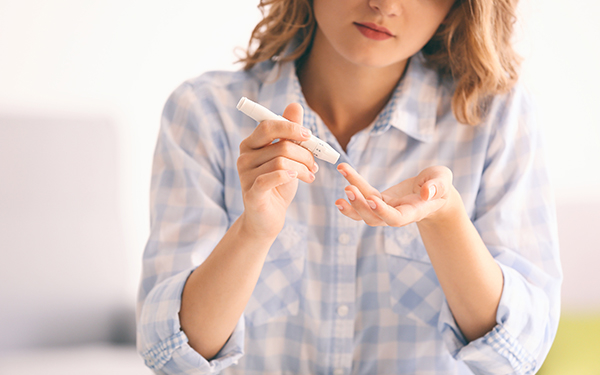Diabetes
America is in the midst of a diabetic crisis. Over the past 20 years, the number of children being diagnosed with diabetes has prompted widespread warnings of an epidemic while the number of adults carrying the diagnosis has more than doubled. Uncontrolled diabetes has now emerged as a major cause of heart disease, kidney failure, severe blindness, peripheral nerve damage, and amputation among adults.
A review of some basic physiology will help to understand why so many individuals are affected with diabetes. Glucose is a sugar the body converts into energy. Insulin is a hormone produced by the pancreas to unlock the cell membrane and allow glucose to enter. Diabetes, therefore, is caused by abnormal glucose metabolism either because the body cannot produce enough insulin (Type 1) or because the cells have become desensitized to the effects of insulin (Type 2). This is why diabetics experience frequent hunger, thirst, and lack of energy. Their cells are actually starving for glucose and cannot make proper energy.
Furthermore, two lethal processes known as glycation and oxidative stress can explain other common symptoms of diabetes. Overabundant blood sugar molecules react with certain proteins to produce damaged proteins called advanced glycation end products (AGEs) which compromise blood passage in the small-diameter capillaries of the fingers, toes, eyes, kidneys, and heart. Oxidative stress occurs when molecules break down into free radicals and damage delicate arterial walls. Many diabetes-related complications like peripheral nerve damage, blurry vision, and kidney disease result.
Every cell in the human body converts glucose to energy for common metabolism. For review, Type 1 diabetes (5-10% of all cases) is caused by an autoimmune reaction in which the body destroys the cells in the pancreas responsible for insulin production. In the medical world, Type 1 diabetics are often prescribed indefinite insulin therapy.
Type 2 (also called “adult onset”) diabetes is the product of insulin-receptor burnout. The insulin receptors on the cell become overworked and insensitive to its attempts to unlock the cell membrane. In early stages, both glucose and insulin levels are elevated. In later stages, only blood glucose levels are elevated as a consequence of insulin resistance.
Symptoms & Diagnosis
While diabetes is usually typified by excess blood glucose, this simplified approach does little to address the damage it causes and can hence accelerate its progression. Glycation and oxidative stress are central to the damage caused by diabetes. Unfortunately, neither of them figures into conventional treatment for diabetes which is generally concerned only with strict blood sugar control.
Many patients are only told of “high blood sugar numbers” or misinformed that their pancreas is malfunctioning. These patients are increasingly being diagnosed as “pre-diabetic” and therefore being made to fear a seemingly unavoidable health disaster. By this definition, literally anyone can be labeled as pre-diabetic. Let’s discuss common laboratory measurements with an understanding that normal fasting blood sugar levels are extremely stable and range between 70-100mg/dL in a healthy person.
- Fasting blood sugar (FBS) measures the amount of glucose in the blood after fasting. Pre-diabetes is diagnosed with levels from 100-125 mg/dL while diabetes is diagnosed by a number over 126 mg/dL.
- Oral glucose tolerance tests (OGTT) measure insulin response to high glucose levels. Patients are given pure glucose, and levels are then measured. Pre-diabetes is diagnosed with levels from 140-199 mg/dL while diabetes is diagnosed by a number over 200 mg/dL.
- The most well-known laboratory value among diabetics is glycated hemoglobin (HbA1c). HbA1c forms when glucose molecules bind to hemoglobin, and measurement can provide a picture of long-term blood glucose control during the preceding two to four months. For diabetics, a healthy HbA1c level is less than 7 percent, which corresponds to an average blood glucose level of 150 mg/dL or less.
Medical Treatment
Unfortunately, many diabetics are prescribed drugs designed solely to boost insulin levels. Considering that insulin levels are already high, this strategy is counterproductive and hastens the disease by further exhausting the insulin receptors on cell membranes. Also, insulin itself is a very powerful hormone that in high levels can suppress the release of growth hormone, inflict cellular damage, and accelerate aging. Ironically, little attention is focused upon reducing blood sugar by dietary changes.

Widely documented for many years, the best defense against Type 2 diabetes is improved diet and exercise. Many nutrients have been shown to increase insulin sensitivity, enhance glucose metabolism, protect vulnerable cell membranes, and reduce the damaging effects of glycation and oxidation. Ideally, a combination of improved diet, moderate physical exercise, and nutritional supplementation has been shown to reverse mild to moderate hyperglycemia before permanent damage occurs from long-term drug use. Usually, the disease state is already characterized by elevated levels of glucose and insulin. Instead, proper a natural healthcare therapy should focus on decreased glucose intake to increase insulin sensitivity on the cell membranes.
In this arena, conventional wisdom has failed us as is evident by the aforementioned statistics. A new understanding of diabetes is desperately needed, and Divine Design Natural Health educates patients appropriately. It is vital that diabetics (and even those labeled as pre-diabetics) understand how the previously mentioned processes of glycation and oxidative stress can be actively interrupted with simple nutritional modifications long before serious threats to life or limb appear.



